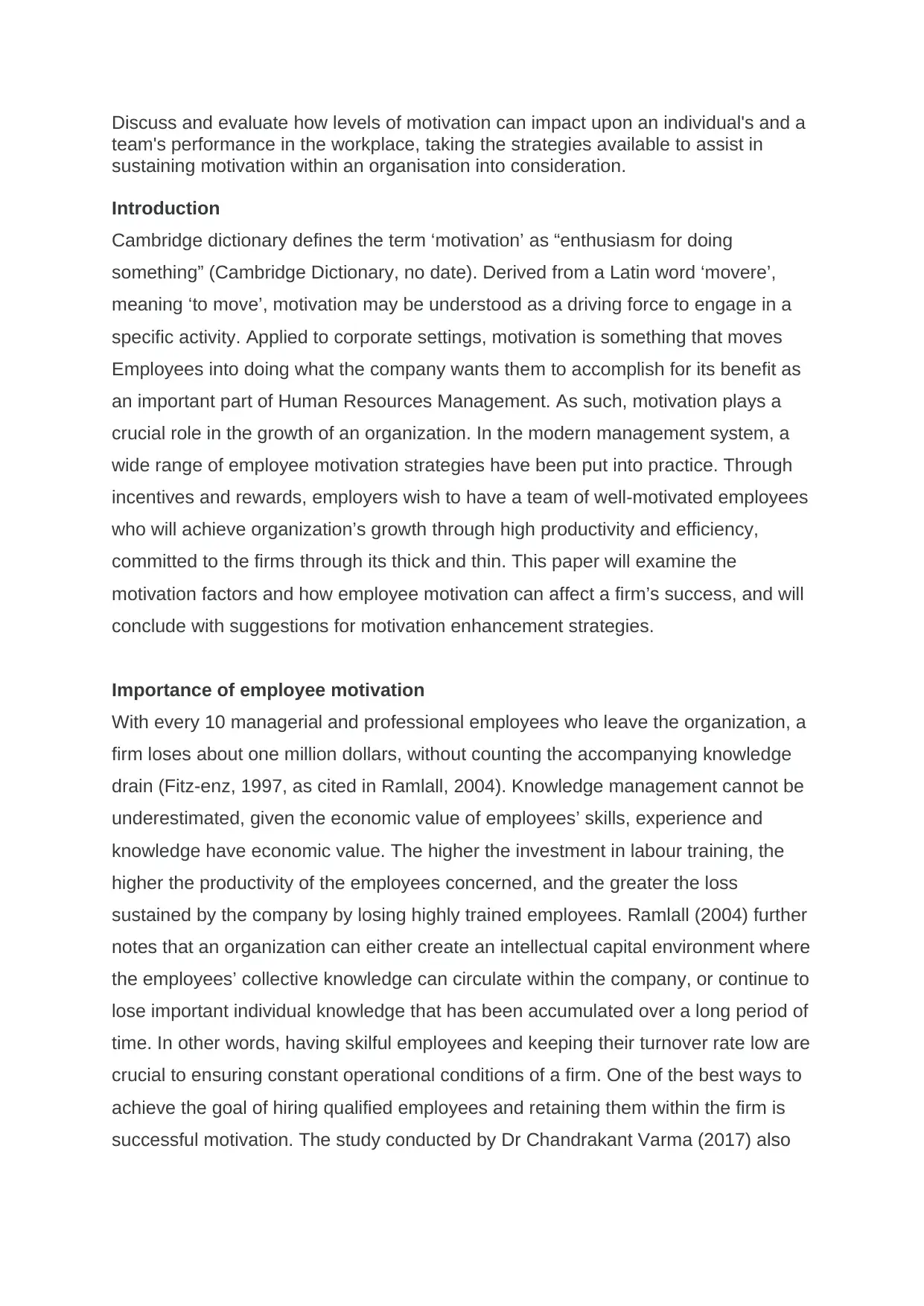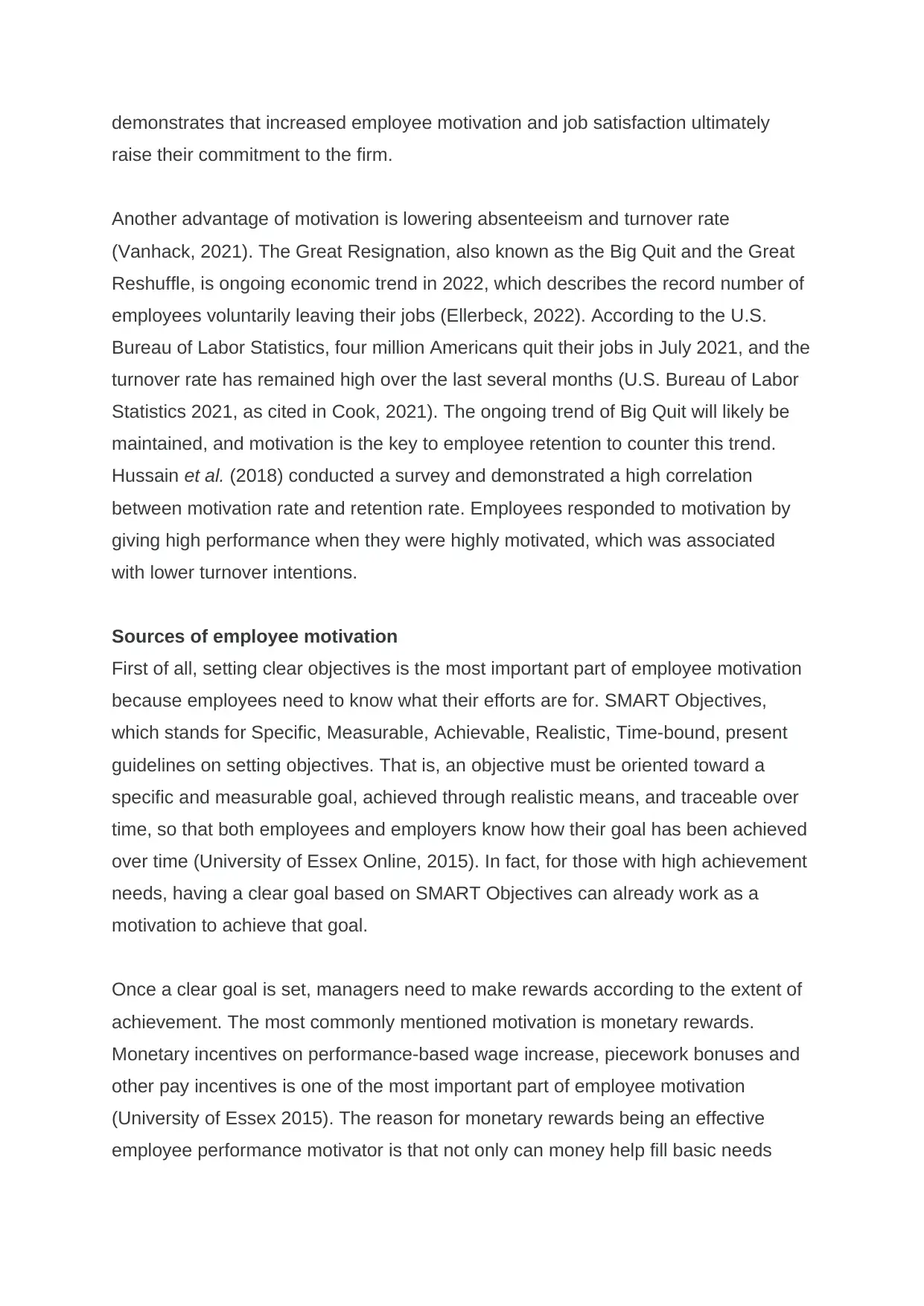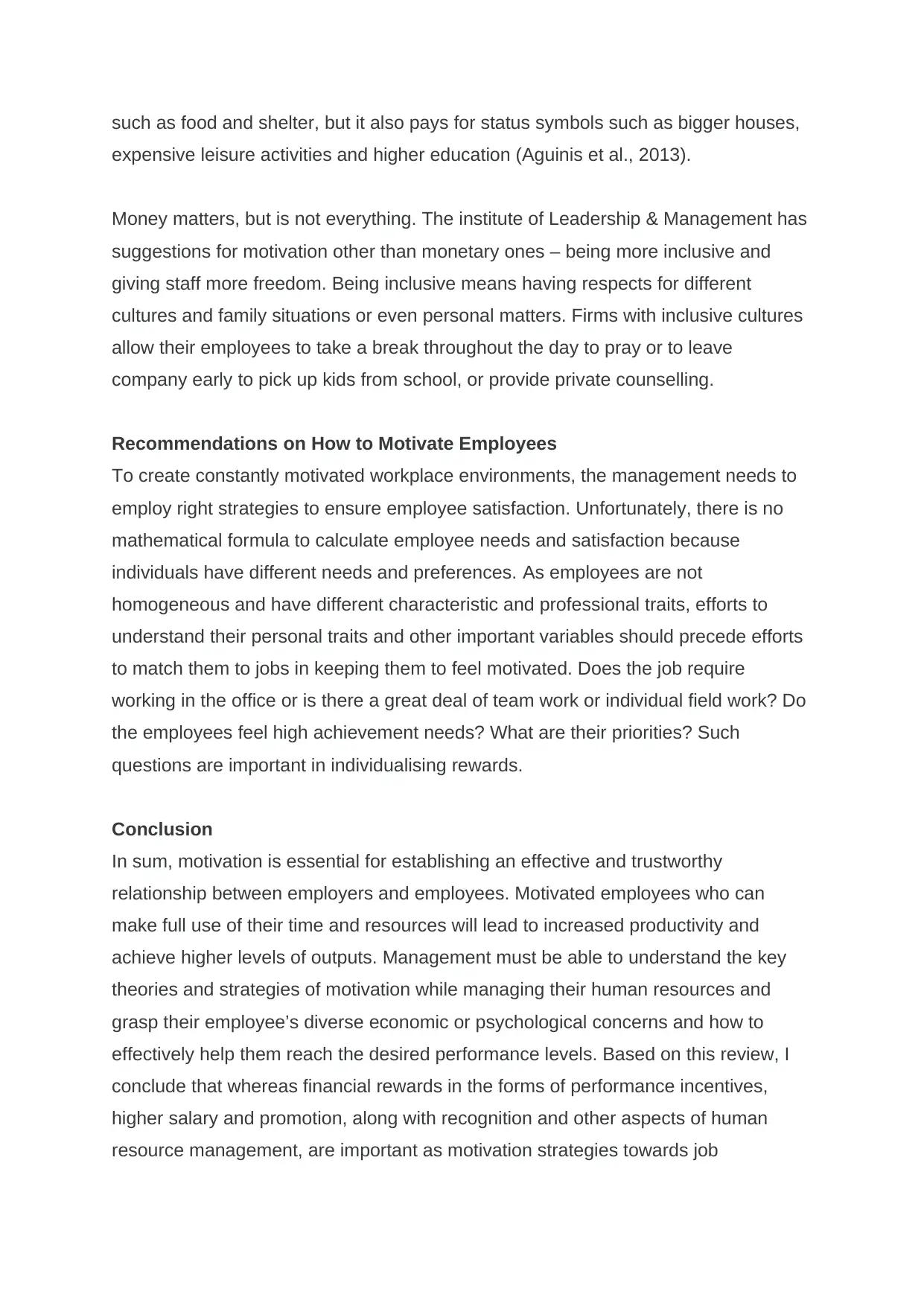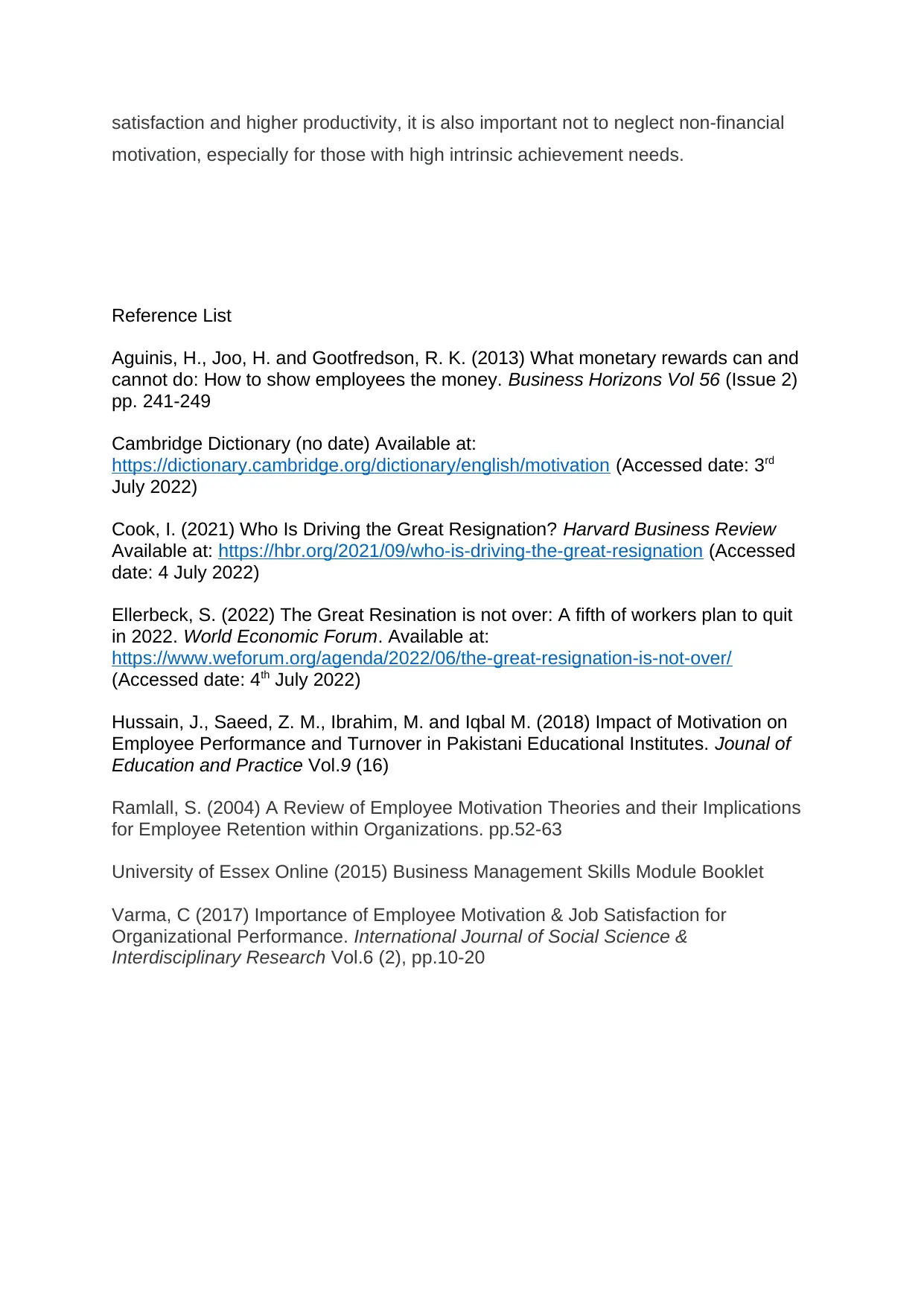Discussing Motivation's Impact on Individual and Team Performance
VerifiedAdded on 2022/09/15
|4
|1450
|195
Essay
AI Summary
This essay examines the critical role of motivation in the workplace, analyzing its impact on both individual and team performance. It begins by defining motivation and its significance in fostering employee engagement and productivity, highlighting the economic value of motivated employees and the costs associated with high turnover rates. The essay explores various sources of employee motivation, including setting clear objectives using SMART goals and implementing reward systems, both monetary and non-monetary. It also delves into the importance of creating inclusive environments that cater to diverse employee needs. The essay further discusses strategies for sustaining motivation, emphasizing the need for personalized approaches that consider individual characteristics and job requirements. Ultimately, the essay concludes that while financial rewards and recognition are important, non-financial motivators are also crucial, particularly for employees with high intrinsic achievement needs. The essay references several studies and research papers to support its arguments, providing a comprehensive overview of the topic.

Discuss and evaluate how levels of motivation can impact upon an individual's and a
team's performance in the workplace, taking the strategies available to assist in
sustaining motivation within an organisation into consideration.
Introduction
Cambridge dictionary defines the term ‘motivation’ as “enthusiasm for doing
something” (Cambridge Dictionary, no date). Derived from a Latin word ‘movere’,
meaning ‘to move’, motivation may be understood as a driving force to engage in a
specific activity. Applied to corporate settings, motivation is something that moves
Employees into doing what the company wants them to accomplish for its benefit as
an important part of Human Resources Management. As such, motivation plays a
crucial role in the growth of an organization. In the modern management system, a
wide range of employee motivation strategies have been put into practice. Through
incentives and rewards, employers wish to have a team of well-motivated employees
who will achieve organization’s growth through high productivity and efficiency,
committed to the firms through its thick and thin. This paper will examine the
motivation factors and how employee motivation can affect a firm’s success, and will
conclude with suggestions for motivation enhancement strategies.
Importance of employee motivation
With every 10 managerial and professional employees who leave the organization, a
firm loses about one million dollars, without counting the accompanying knowledge
drain (Fitz-enz, 1997, as cited in Ramlall, 2004). Knowledge management cannot be
underestimated, given the economic value of employees’ skills, experience and
knowledge have economic value. The higher the investment in labour training, the
higher the productivity of the employees concerned, and the greater the loss
sustained by the company by losing highly trained employees. Ramlall (2004) further
notes that an organization can either create an intellectual capital environment where
the employees’ collective knowledge can circulate within the company, or continue to
lose important individual knowledge that has been accumulated over a long period of
time. In other words, having skilful employees and keeping their turnover rate low are
crucial to ensuring constant operational conditions of a firm. One of the best ways to
achieve the goal of hiring qualified employees and retaining them within the firm is
successful motivation. The study conducted by Dr Chandrakant Varma (2017) also
team's performance in the workplace, taking the strategies available to assist in
sustaining motivation within an organisation into consideration.
Introduction
Cambridge dictionary defines the term ‘motivation’ as “enthusiasm for doing
something” (Cambridge Dictionary, no date). Derived from a Latin word ‘movere’,
meaning ‘to move’, motivation may be understood as a driving force to engage in a
specific activity. Applied to corporate settings, motivation is something that moves
Employees into doing what the company wants them to accomplish for its benefit as
an important part of Human Resources Management. As such, motivation plays a
crucial role in the growth of an organization. In the modern management system, a
wide range of employee motivation strategies have been put into practice. Through
incentives and rewards, employers wish to have a team of well-motivated employees
who will achieve organization’s growth through high productivity and efficiency,
committed to the firms through its thick and thin. This paper will examine the
motivation factors and how employee motivation can affect a firm’s success, and will
conclude with suggestions for motivation enhancement strategies.
Importance of employee motivation
With every 10 managerial and professional employees who leave the organization, a
firm loses about one million dollars, without counting the accompanying knowledge
drain (Fitz-enz, 1997, as cited in Ramlall, 2004). Knowledge management cannot be
underestimated, given the economic value of employees’ skills, experience and
knowledge have economic value. The higher the investment in labour training, the
higher the productivity of the employees concerned, and the greater the loss
sustained by the company by losing highly trained employees. Ramlall (2004) further
notes that an organization can either create an intellectual capital environment where
the employees’ collective knowledge can circulate within the company, or continue to
lose important individual knowledge that has been accumulated over a long period of
time. In other words, having skilful employees and keeping their turnover rate low are
crucial to ensuring constant operational conditions of a firm. One of the best ways to
achieve the goal of hiring qualified employees and retaining them within the firm is
successful motivation. The study conducted by Dr Chandrakant Varma (2017) also
Paraphrase This Document
Need a fresh take? Get an instant paraphrase of this document with our AI Paraphraser

demonstrates that increased employee motivation and job satisfaction ultimately
raise their commitment to the firm.
Another advantage of motivation is lowering absenteeism and turnover rate
(Vanhack, 2021). The Great Resignation, also known as the Big Quit and the Great
Reshuffle, is ongoing economic trend in 2022, which describes the record number of
employees voluntarily leaving their jobs (Ellerbeck, 2022). According to the U.S.
Bureau of Labor Statistics, four million Americans quit their jobs in July 2021, and the
turnover rate has remained high over the last several months (U.S. Bureau of Labor
Statistics 2021, as cited in Cook, 2021). The ongoing trend of Big Quit will likely be
maintained, and motivation is the key to employee retention to counter this trend.
Hussain et al. (2018) conducted a survey and demonstrated a high correlation
between motivation rate and retention rate. Employees responded to motivation by
giving high performance when they were highly motivated, which was associated
with lower turnover intentions.
Sources of employee motivation
First of all, setting clear objectives is the most important part of employee motivation
because employees need to know what their efforts are for. SMART Objectives,
which stands for Specific, Measurable, Achievable, Realistic, Time-bound, present
guidelines on setting objectives. That is, an objective must be oriented toward a
specific and measurable goal, achieved through realistic means, and traceable over
time, so that both employees and employers know how their goal has been achieved
over time (University of Essex Online, 2015). In fact, for those with high achievement
needs, having a clear goal based on SMART Objectives can already work as a
motivation to achieve that goal.
Once a clear goal is set, managers need to make rewards according to the extent of
achievement. The most commonly mentioned motivation is monetary rewards.
Monetary incentives on performance-based wage increase, piecework bonuses and
other pay incentives is one of the most important part of employee motivation
(University of Essex 2015). The reason for monetary rewards being an effective
employee performance motivator is that not only can money help fill basic needs
raise their commitment to the firm.
Another advantage of motivation is lowering absenteeism and turnover rate
(Vanhack, 2021). The Great Resignation, also known as the Big Quit and the Great
Reshuffle, is ongoing economic trend in 2022, which describes the record number of
employees voluntarily leaving their jobs (Ellerbeck, 2022). According to the U.S.
Bureau of Labor Statistics, four million Americans quit their jobs in July 2021, and the
turnover rate has remained high over the last several months (U.S. Bureau of Labor
Statistics 2021, as cited in Cook, 2021). The ongoing trend of Big Quit will likely be
maintained, and motivation is the key to employee retention to counter this trend.
Hussain et al. (2018) conducted a survey and demonstrated a high correlation
between motivation rate and retention rate. Employees responded to motivation by
giving high performance when they were highly motivated, which was associated
with lower turnover intentions.
Sources of employee motivation
First of all, setting clear objectives is the most important part of employee motivation
because employees need to know what their efforts are for. SMART Objectives,
which stands for Specific, Measurable, Achievable, Realistic, Time-bound, present
guidelines on setting objectives. That is, an objective must be oriented toward a
specific and measurable goal, achieved through realistic means, and traceable over
time, so that both employees and employers know how their goal has been achieved
over time (University of Essex Online, 2015). In fact, for those with high achievement
needs, having a clear goal based on SMART Objectives can already work as a
motivation to achieve that goal.
Once a clear goal is set, managers need to make rewards according to the extent of
achievement. The most commonly mentioned motivation is monetary rewards.
Monetary incentives on performance-based wage increase, piecework bonuses and
other pay incentives is one of the most important part of employee motivation
(University of Essex 2015). The reason for monetary rewards being an effective
employee performance motivator is that not only can money help fill basic needs

such as food and shelter, but it also pays for status symbols such as bigger houses,
expensive leisure activities and higher education (Aguinis et al., 2013).
Money matters, but is not everything. The institute of Leadership & Management has
suggestions for motivation other than monetary ones – being more inclusive and
giving staff more freedom. Being inclusive means having respects for different
cultures and family situations or even personal matters. Firms with inclusive cultures
allow their employees to take a break throughout the day to pray or to leave
company early to pick up kids from school, or provide private counselling.
Recommendations on How to Motivate Employees
To create constantly motivated workplace environments, the management needs to
employ right strategies to ensure employee satisfaction. Unfortunately, there is no
mathematical formula to calculate employee needs and satisfaction because
individuals have different needs and preferences. As employees are not
homogeneous and have different characteristic and professional traits, efforts to
understand their personal traits and other important variables should precede efforts
to match them to jobs in keeping them to feel motivated. Does the job require
working in the office or is there a great deal of team work or individual field work? Do
the employees feel high achievement needs? What are their priorities? Such
questions are important in individualising rewards.
Conclusion
In sum, motivation is essential for establishing an effective and trustworthy
relationship between employers and employees. Motivated employees who can
make full use of their time and resources will lead to increased productivity and
achieve higher levels of outputs. Management must be able to understand the key
theories and strategies of motivation while managing their human resources and
grasp their employee’s diverse economic or psychological concerns and how to
effectively help them reach the desired performance levels. Based on this review, I
conclude that whereas financial rewards in the forms of performance incentives,
higher salary and promotion, along with recognition and other aspects of human
resource management, are important as motivation strategies towards job
expensive leisure activities and higher education (Aguinis et al., 2013).
Money matters, but is not everything. The institute of Leadership & Management has
suggestions for motivation other than monetary ones – being more inclusive and
giving staff more freedom. Being inclusive means having respects for different
cultures and family situations or even personal matters. Firms with inclusive cultures
allow their employees to take a break throughout the day to pray or to leave
company early to pick up kids from school, or provide private counselling.
Recommendations on How to Motivate Employees
To create constantly motivated workplace environments, the management needs to
employ right strategies to ensure employee satisfaction. Unfortunately, there is no
mathematical formula to calculate employee needs and satisfaction because
individuals have different needs and preferences. As employees are not
homogeneous and have different characteristic and professional traits, efforts to
understand their personal traits and other important variables should precede efforts
to match them to jobs in keeping them to feel motivated. Does the job require
working in the office or is there a great deal of team work or individual field work? Do
the employees feel high achievement needs? What are their priorities? Such
questions are important in individualising rewards.
Conclusion
In sum, motivation is essential for establishing an effective and trustworthy
relationship between employers and employees. Motivated employees who can
make full use of their time and resources will lead to increased productivity and
achieve higher levels of outputs. Management must be able to understand the key
theories and strategies of motivation while managing their human resources and
grasp their employee’s diverse economic or psychological concerns and how to
effectively help them reach the desired performance levels. Based on this review, I
conclude that whereas financial rewards in the forms of performance incentives,
higher salary and promotion, along with recognition and other aspects of human
resource management, are important as motivation strategies towards job
⊘ This is a preview!⊘
Do you want full access?
Subscribe today to unlock all pages.

Trusted by 1+ million students worldwide

satisfaction and higher productivity, it is also important not to neglect non-financial
motivation, especially for those with high intrinsic achievement needs.
Reference List
Aguinis, H., Joo, H. and Gootfredson, R. K. (2013) What monetary rewards can and
cannot do: How to show employees the money. Business Horizons Vol 56 (Issue 2)
pp. 241-249
Cambridge Dictionary (no date) Available at:
https://dictionary.cambridge.org/dictionary/english/motivation (Accessed date: 3rd
July 2022)
Cook, I. (2021) Who Is Driving the Great Resignation? Harvard Business Review
Available at: https://hbr.org/2021/09/who-is-driving-the-great-resignation (Accessed
date: 4 July 2022)
Ellerbeck, S. (2022) The Great Resination is not over: A fifth of workers plan to quit
in 2022. World Economic Forum. Available at:
https://www.weforum.org/agenda/2022/06/the-great-resignation-is-not-over/
(Accessed date: 4th July 2022)
Hussain, J., Saeed, Z. M., Ibrahim, M. and Iqbal M. (2018) Impact of Motivation on
Employee Performance and Turnover in Pakistani Educational Institutes. Jounal of
Education and Practice Vol.9 (16)
Ramlall, S. (2004) A Review of Employee Motivation Theories and their Implications
for Employee Retention within Organizations. pp.52-63
University of Essex Online (2015) Business Management Skills Module Booklet
Varma, C (2017) Importance of Employee Motivation & Job Satisfaction for
Organizational Performance. International Journal of Social Science &
Interdisciplinary Research Vol.6 (2), pp.10-20
motivation, especially for those with high intrinsic achievement needs.
Reference List
Aguinis, H., Joo, H. and Gootfredson, R. K. (2013) What monetary rewards can and
cannot do: How to show employees the money. Business Horizons Vol 56 (Issue 2)
pp. 241-249
Cambridge Dictionary (no date) Available at:
https://dictionary.cambridge.org/dictionary/english/motivation (Accessed date: 3rd
July 2022)
Cook, I. (2021) Who Is Driving the Great Resignation? Harvard Business Review
Available at: https://hbr.org/2021/09/who-is-driving-the-great-resignation (Accessed
date: 4 July 2022)
Ellerbeck, S. (2022) The Great Resination is not over: A fifth of workers plan to quit
in 2022. World Economic Forum. Available at:
https://www.weforum.org/agenda/2022/06/the-great-resignation-is-not-over/
(Accessed date: 4th July 2022)
Hussain, J., Saeed, Z. M., Ibrahim, M. and Iqbal M. (2018) Impact of Motivation on
Employee Performance and Turnover in Pakistani Educational Institutes. Jounal of
Education and Practice Vol.9 (16)
Ramlall, S. (2004) A Review of Employee Motivation Theories and their Implications
for Employee Retention within Organizations. pp.52-63
University of Essex Online (2015) Business Management Skills Module Booklet
Varma, C (2017) Importance of Employee Motivation & Job Satisfaction for
Organizational Performance. International Journal of Social Science &
Interdisciplinary Research Vol.6 (2), pp.10-20
1 out of 4
Your All-in-One AI-Powered Toolkit for Academic Success.
+13062052269
info@desklib.com
Available 24*7 on WhatsApp / Email
![[object Object]](/_next/static/media/star-bottom.7253800d.svg)
Unlock your academic potential
Copyright © 2020–2025 A2Z Services. All Rights Reserved. Developed and managed by ZUCOL.